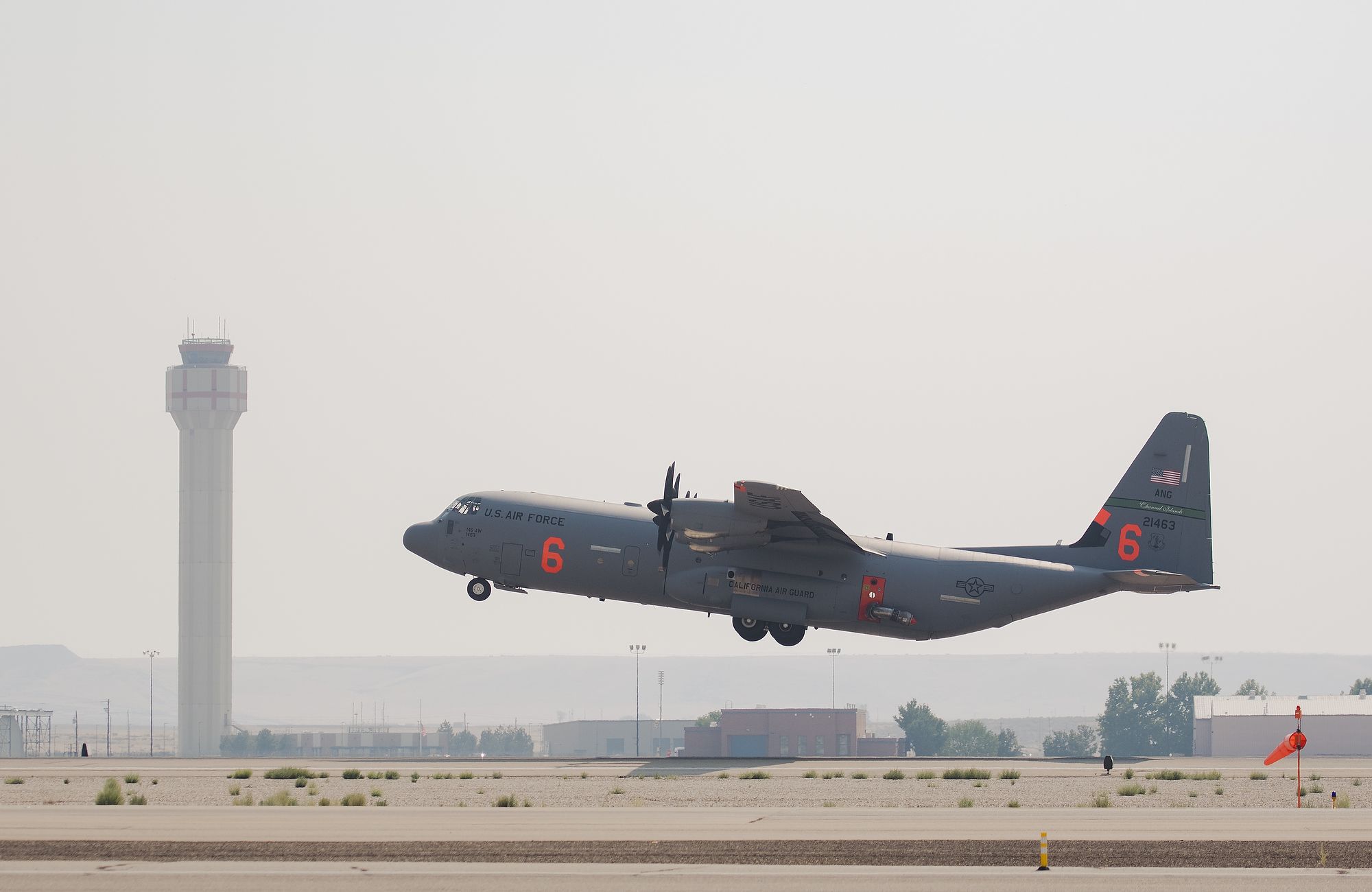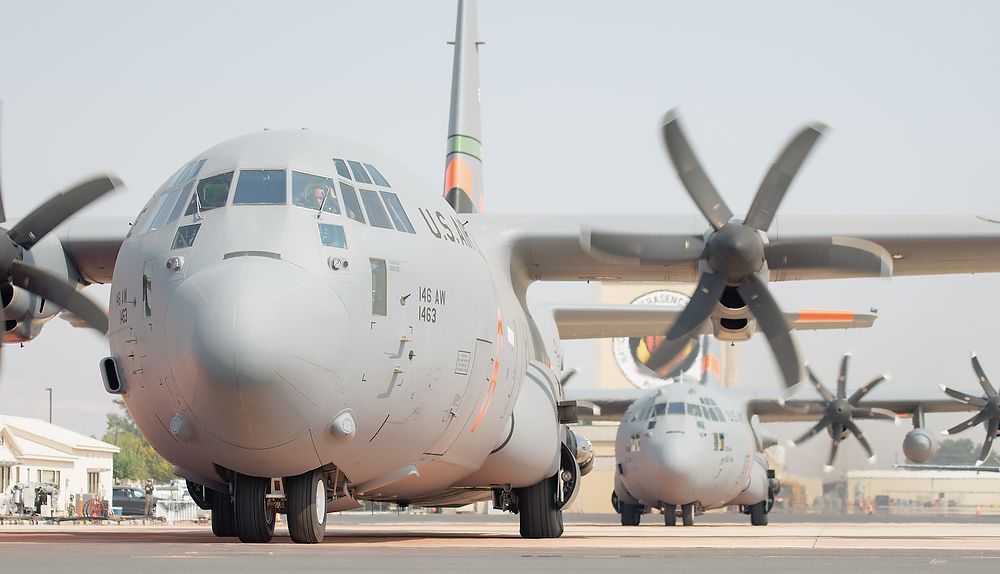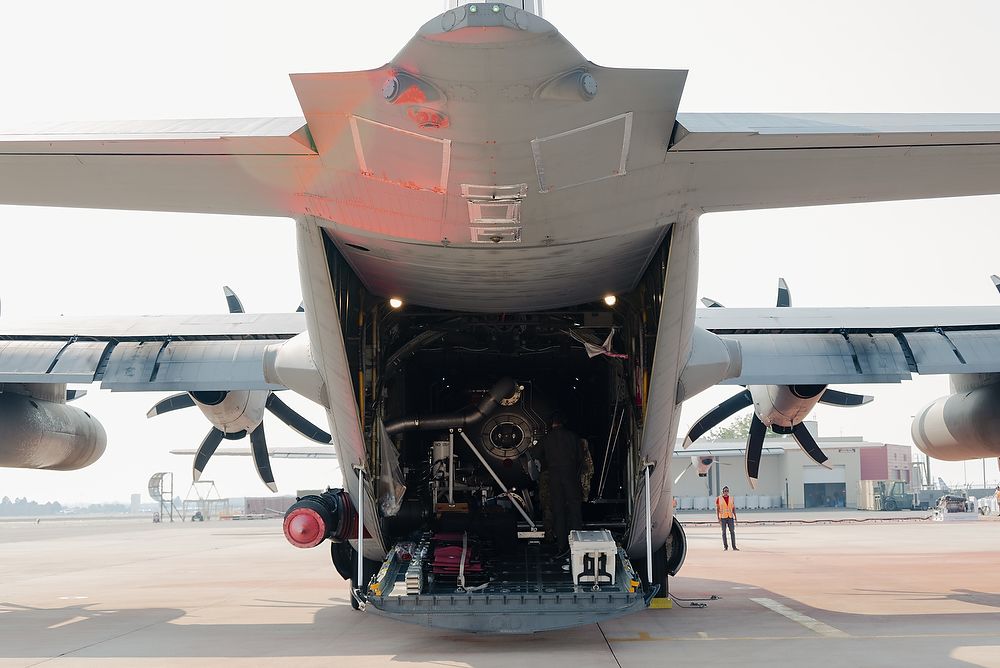MAFFS-enabled C-130 aircraft assisting fire suppression in northwestern U.S.
National Interagency Fire Center requests support from California and Nevada Air National Guard units

Story and photos by Senior Airman Thomas Cox
152nd Airlift Wing Public Affairs
Sept. 21, 2022
BOISE, Idaho – Two modular airborne firefighting systems (MAFFS)-enabled U.S. Air Force C-130 aircraft arrived at Boise Tanker Base, Idaho, Sept. 9.
One C-130H Hercules from the Nevada Air National Guard’s 152nd Airlift Wing and one C-130J Super Hercules from the Cal Guard’s 146th Airlift Wing were called up to assist with wildland firefighting efforts due to increased fire activity in the Northwestern United States.
The request for support came from the National Interagency Fire Center to the Department of Defense’s U.S. Northern Command, the major command that exercises operational control of the aircraft through U.S. Air Forces Northern. The National Interagency Fire Center assigns the aircraft to airtanker bases and assign the aircraft missions.
As of Sept. 12, MAFFS crews have flown a total of four sorties and dropped 11,556 gallons of retardant in support of suppression efforts for the Jordan Creek Fire in eastern Oregon.
These efforts contributed to the fire’s containment and restriction of spread as it was no longer being reported on any situation reports regarding active wildland fires.
"We take to heart our team's effort to help protect property and critical infrastructure, with the ultimate goal of saving lives," said Lt. Gen. Kirk Pierce, commander of First Air Force - Air Forces Northern. "Our MAFFS-trained team of professionals completed rigorous annual aerial wildland firefighting training in April with the USDA Forest Service to ensure they were fully prepared for the wildfire season."
In addition to the 146th and 152nd Airlift Wings, MAFFS program aircraft are also from the Air Force Reserve Command’s 302nd Airlift Wing at Peterson Air Force Base in Colorado, and the Air National Guard’s 153rd Airlift Wing in Cheyenne, Wyoming.
The C-130 aircraft equipped with the U.S. Forest Service’s MAFFS can drop up to 3,000 gallons of fire retardant in less than 10 seconds across a quarter-mile line. The system slides into the back of the military aircraft, and retardant is released through a nozzle that is outfitted out of the rear left paratroop door.
The number of MAFFS-equipped aircraft flights each year varies with wildland fire activity. Over the last 14 years, federally activated, military C-130s equipped with MAFFS have delivered more than 10 million gallons of fire retardant on wildland fires, an average of 757,000 gallons per year. In 2021, all eight aircraft were activated to federalized status during the second-busiest fire season in 49 years.
“We've trained and prepared well to be called into action this fire season,” said Col. Evan Kirkwood, 152nd Air Expeditionary Group MAFFS commander. “As citizen-Airmen, we are always honored to help our community, state and nation. Last year was an unprecedented fire year and I continue to be humbled by the outstanding work showcased by the amazing Airmen I serve with. Our ability to continue contributing to this vital mission is only made possible by the outstanding interagency teamwork with all other agencies involved.”

Two Modular Airborne Firefighting Systems (MAFFS) equipped C-130 aircraft from Cal Guard’s 146th Airlift Wing, foreground, and Nevada Air National Guard’s 152nd Airlift Wing, background, prepare to be launched on a fire suppression mission at the Boise Tanker Base, Idaho, Sept. 10. The United States Department of Agriculture Forest Service activated two Department of Defense C-130 aircraft equipped with MAFFS to assist with increased fire activity in several western states. (U.S. Air National Guard photo by Senior Airman Thomas Cox)
Two Modular Airborne Firefighting Systems (MAFFS) equipped C-130 aircraft from Cal Guard’s 146th Airlift Wing, foreground, and Nevada Air National Guard’s 152nd Airlift Wing, background, prepare to be launched on a fire suppression mission at the Boise Tanker Base, Idaho, Sept. 10. The United States Department of Agriculture Forest Service activated two Department of Defense C-130 aircraft equipped with MAFFS to assist with increased fire activity in several western states. (U.S. Air National Guard photo by Senior Airman Thomas Cox)

A U.S. Forest Service Modular Airborne Firefighting Systems Airtanker Base Specialists prepares to load a C-130J Super Hercules aircraft from Cal Guard’s 146th Airlift Wing at Boise Tanker Base, Idaho, Sept. 10.
A U.S. Forest Service Modular Airborne Firefighting Systems Airtanker Base Specialists prepares to load a C-130J Super Hercules aircraft from Cal Guard’s 146th Airlift Wing at Boise Tanker Base, Idaho, Sept. 10.

A Modular Airborne Firefighting System (MAFFS) is seen inside a C-130H Hercules aircraft from the Nevada Air National Guard’s 152nd Airlift Wing as it is prepared for launch in Idaho to a fire suppression mission, Sept. 10.
A Modular Airborne Firefighting System (MAFFS) is seen inside a C-130H Hercules aircraft from the Nevada Air National Guard’s 152nd Airlift Wing as it is prepared for launch in Idaho to a fire suppression mission, Sept. 10.


